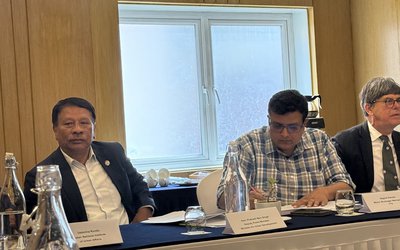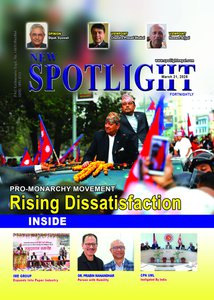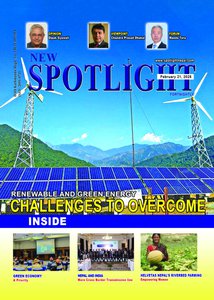Before talking about the contribution of rains to our economy, more specifically GDP, it may be advisable to touch upon some noteworthy developments on some other fronts such as judiciary and medical education. After several rounds of talks with the government, Dr. Govinda KC, senior orthopedic surgeon, ended his fast-on- to –death on the twenty seventh day. A nine point agreement reached between the two parties contained, amongst others, a 10-year moratorium on establishing new medical colleges in Kathmandu, which had been the major bone of contention in the talks. One day after the ending of fast, the National Medical Education Bill was presented to the House. The major opposition party, which was obstructing the House proceedings, allowed the normal operation after receiving assurance from the government that the nine-point agreement it had reached with Dr. KC would be executed through amendment.NC must be happy that the Oli-led government succumbed to pressure exerted on it from different quarters but the major opposition party, desperately in need of an issue, may have also realized that it is now without an issue to shout against the government. Refusal of the Parliamentary Hearing Committee (PHC) to endorse Acting Chief Justice Deepak Raj Joshee as the head of judiciary has, however, given the NC something to watch and act. It may be noted that the PHC remained undecided for days on account of differences between the ruling and opposition parties whether to endorse the recommendation of the Constitutional Council headed by Prime Minister Oli.While lawmakers of the ruling party were against Joshee, citing his dubious academic certificate and controversial rulings, the NC lawmakers, however, wanted Joshee to be the Chief Justice. Since consensus decision looked difficult to arrive at and the Committee remained indecisive for more than a week after hearing, the ruling party members took the bold but controversial decision of rejecting Joshee on the strength of a two-third majority votes against him. It is interesting that the opposition party did not enter into the process and has stated that the PHC act has undermined independence of judiciary and democracy. Likewise, Nepal Bar Association has condemned the decision of the hearing committee. With the victim Joshee on leave and NC solidly against this act of PHC, it would be interesting to see how Prime Minister Oli resolves this case involving his own nominee Joshee who is considered relatively sober and a less controversial person in the much- talked-about present day judiciary of Nepal. Om Prakash Mishra has been tasked with running the affairs at the apex court and is likely to be recommended by the Constitutional Council to face the PHC.
The government, almost is on the verge of being seriously accused of non-performance, has at last something to derive some solace from, which has its root in the continuing monsoon of this year. Each year, monsoonal rains do some harm and some good to the economy and the country. Usually, when benefits derived from the rains exceed the harm inflicted on the economy, our economy grows satisfactorily. This year’s monsoon also has been devastating in that rain-triggered flood, landslips and inundation have resulted in loss of human lives and property and also causing serious inconvenience to people in rural as well as urban areas. Along with the sad information on loss of lives and property came the good news that paddy production is going to increase by about 15 percent, which is attributed to adequate quantity of water from the sky. It may be recalled that last year also paddy production increased to reach 51 lakh 52 thousand metric ton and this year it is likely to reach 58 lakh metric ton. Compared to last year, acreage under paddy has increased by 15 percent to reach 14 lakh 32 thousand and 315 hectare and is likely to increase some more. As a result of this increase in area under paddy and expected production, Nepal’s GDP is likely to increase by 1.5 percent on account of rice alone. It may be noted that paddy accounts for 20 percent of total agricultural GDP.It is a matter of common knowledge that performance of the economy is largely influenced by the state of agriculture in a particular year, which again has a lot to do with rains from the sky, ours being mainly a rain-fed agriculture. This year, rains seem to have been doing good as is clear from the statistics made available by the concerned authorities. This likely windfall must have made the duo (Oli and Khatiwada) happy that the expected 8 percent growth of the economy may not remain a distant dream because they also know that the industrial sector, no more taking the brunt of power outage currently, is likely to contribute in a significant way to economic growth. A recent report of the World Bank has stated that due to severe load shedding, Nepal lost the opportunity of attaining a 7 percent growth in the last decade (2008-2016).Power outage has been cited as the main culprit impeding industrial development in Nepal. Looks like Indra jee (the rain god) and Kulman jee(the man who did away with power outage) have joined hands to rescue this government at a time when they have not at all been able to perform and disheartening information about performance of our economy in the recently completed fiscal year are pouring in.
It is a big disappointment that, contrary to the information provided by the Ministry of Finance, revenue collection suffered a setback, which had been exceeding the target each year in the last decade. It may be noted that the ministry had stated in a press conference that revenue collection last year had exceeded the target by Rs. 2 billion to reach Rs.732 billion but data made available by Nepal Rastra Bank and the Financial Comptroller General Office show that revenue collection in the year was only Rs. 726 billion, clearly showing that it fell sort of target for the first time in a decade. It would be unfair to put the entire blame for the debacle on the current dispensation because most parts of the last fiscal year, Oli and Khatiwada were not managing state affairs but they definitely owe public an apology for the misleading information formally provided in a press conference organized by the ministry soon after the annual closing. Alternatively, the duo may wish to further delve into the subject and try to prove the reliable agencies mentioned above wrong. Even more shocking are the information related to the external sector of the economy. In fiscal 2074\75, trade deficit increased by 27.53 percent to reach Rs. 1162.10 billion. The acute trade imbalance is shown by the low level of exports (Rs.81.19 billion), which accounted for only 6 percent of Nepal’s total trade of Rs.1324.29 billion in the last fiscal year. Of the 140 countries that Nepal is trading with currently, India is our major trading partner and each year we have been suffering a huge trade imbalance with India, it being Rs.764.30 billion in the recently ended fiscal year. Nepal imported petroleum products worth Rs.190.85 billion in the last fiscal year. It is very likely that Nepal’s trade imbalance last year will exceed the budgetary outlay when actual figures are made available in due course of time. With his six month’s performance poorly rated by people, Prime Minister Oli’s attention must have been attracted by these imbalances in the economy. He must have noted by now that the United States is also suffering huge trade deficit with its major trading partners but the difference between us and the number one economy in the world is that they have lots of exportable at their disposal while Nepal does not have any mention worthy items for export. It may not be inappropriate to touch upon how President Trump is engaged in tough negotiations with his major trading partners to extract concessions for his country.
In March of this year, the US government imposed a 25 percent tariff on steel and aluminum import, which encouraged China, EU, Mexico, etc to impose taxes on imports of whiskey,wine,pork from the US. Pig, beef and soya farmers have begun to suffer as their domestic prices have plummeted but Trump is not the man to yield easily and is in constant negotiations. Trump emerged somewhat victorious recently when he and the president of the European Commission (Jean-Claude Juncker) agreed to find ways to lower tariffs and other barriers to each other’s exports. The deal struck calls for the Europeans to buy more American petroleum, soybeans and manufactured goods and for the US to reduce auto and steel tariff.Mr. Trump wanted that both the US and the EU drop all tariff, non-tariff barriers and subsidies. It is now becoming clear that Trump’s threat of tariff is a negotiating tactic to get to a lower trade barriers and a level playing field. Trump is likely to extend this zero tariff proposal to other key allies such as Britain, Canada, Mexico and South Korea. It is, however, difficult to say what he has in mind to settle dispute with China, which has also begun retaliatory imposition of tariff on imports from the US.Mr. Trump must also be aware of the fact American firms operating in China generate internal demand worth 300 billion dollars and his country enjoys a surplus position (38 billion dollar) in service trade, which is a result of some 113 million Chinese visiting the US annually (2016) and spending around 260 billion dollar. In addition, China has around 10 trillion dollars invested in US security papers the withdrawal of which could create problems for the number one economy. The US may also be fearing that China could take resort to currency manipulation (depreciating Yuan) to augment export to other countries. China, which is now focusing more on internal demand rather than export for sustainable growth, looks well equipped to carry on the trade battle with the US and is not likely to be squeezed into unilaterally extending huge concessions to Trump. Let us pray that the trade war does not flare much to complicate the global economy, which could slow down on account of rising fossil fuel prices and the trade war between the two economies. As far as Nepal’s case is concerned, Mr. oli may wish to learn a bit from how world leaders get indulged in tough negotiations to protect the interest of their respective countries and he may not get much frustrated, despite poor half yearly performance, that he has got some areas that show some encouraging signs such as expected increase in paddy output, encouraging foreign direct investment commitment, which increased 4 times to reach Rs.55.64 billion last fiscal year. Finance Minister Khatiwada’s saying that the World Bank will double its aid amount starting next year (2019) may also have given some strength to the ailing head of government. The duo may also remember People’s agitation against excessive taxes at different levels which warrants immediate attention and action because letting the situation continue for long will not only slow down economic activities but also strengthen the arguments of those branding federalism as an expensive system of governance. Let us hope the government gets a better annual report card after six months.

Dr. Tilak Rawal
Dr. Rawal is former governor of NRB.
- Six Months Of Deuba And Oli
- Jan 25, 2025
- Prachanda Outsmarted
- Jul 19, 2024
- Prachanda Outsmarts Again
- Apr 14, 2024
- Prachanda Completes One Year
- Jan 26, 2024
- Terrible Times To Continue
- Oct 12, 2023














